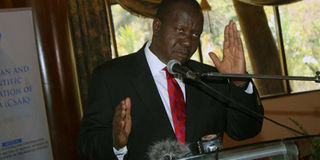Premium
We should abolish national schools, redirect public funds to where they're needed most

Fred Matiang'i, the Cabinet Secretary for the Ministry of Education, Science and Technology in Nairobi on September 9, 2016. PHOTO | ANTHONY OMUYA | NATION MEDIA GROUP
What you need to know:
One does not need a “national” school to bring children from diverse backgrounds together.
Promotion of national schools has turned out to be a case of the solution being worse than the problem – attempting to cure ethnic cleavages by creating social class-based fragmentation.
What is a national school?
There is no classification of schools in the Basic Education Act.
I was privileged to participate in one of the many low-key events organised to mark the Equity Week, whose purpose was to reflect on the many facets of inequality in our society. It was disconcerting how low key the week-long series of events turned out to be. This set me wondering whether, as a society, we fully understand the extent of inequalities in our nation and the ominous cloud they cast on our collective future.
Our society is dangerously, systemically unequal. No sector illustrates this fact better than our secondary school system. I make this argument while cognisant of the government’s efforts to improve access for all children. It is noteworthy that the primary to secondary school transition rate has improved significantly from 72.5 per cent in 2010 to 82 per cent in 2016.
Yet access alone is not enough. The fourth Sustainable Development Goal, which Kenya has committed to, obligates governments to “ensure inclusive and equitable quality education and promote lifelong learning opportunities for all”.
One of the measures instituted by the government, ostensibly to bring equity into the secondary school system, stir educational excellence, and promote national cohesion, is increasing the number of national schools from 18 to 114. This policy is faulty in theory and practice. It is faulty in theory because first, one does not need a “national” school to bring children from diverse backgrounds together. This is simply a school placement policy issue. Secondly, promotion of national schools has turned out to be a case of the solution being worse than the problem – attempting to cure ethnic cleavages by creating social class-based fragmentation. The latter is a more potent threat to social cohesion.
Thirdly, what is a national school? There is no classification of schools in the Basic Education Act. Therefore the skewed allocation of public resources to these favoured schools is blatant discrimination against the children who attend underprivileged public schools.
In practice, here are important figures I would like us to ponder on for a moment. According to the 2016/17 budget estimates, Kenya plans to spend Sh2.55 billion on secondary schools infrastructure development in the next three years. The amount will increase from Sh600 million in 2016/17 to Sh900 million in 2017/18 and Sh1.05 billion in the 2018/19 fiscal years. Upgrading national schools is allocated Sh300 million, Sh700 million, and Sh700 million respectively for the three fiscal years. In the same period, secondary schools infrastructure improvement is allocated Sh300 million, Sh200 million, and Sh350 million respectively.
SECONDARY SCHOOLS
From the 2014 basic education statistical booklet, there are 7,686 public secondary schools, out of which 114 are national. The number of children enrolled in public secondary schools by 2014 were 2,175,036. In 2016, 759,603 children were admitted to public secondary schools, 90,860 of them to national schools.
Assuming this ratio to have been constant for the past four years, then it means that 12 per cent of the children enrolled in public secondary schools attend national schools. Yet in this fiscal year, national schools will 'guzzle' 50 per cent of all development funds allocated to secondary schools. This figure is projected to rise to 67 per cent by 2019.
So, which children attend these privileged schools? Are they from different parts of Kenya? Yes. Are they from different ethnicities and religions? Yes. Are they from different socio-economic backgrounds? NO! Save for a few lucky cases who benefit from bursaries and other sponsorship, these schools are exclusively for the rich. The average annual fees charged is way out of the reach of poor households. In short, the schools have been privatised, yet they receive a disproportionate share of government funding.
These schools also boast parents with means to support their development projects. Consequently, their facilities are worlds apart from those in small schools in rural and marginalised areas. The recently enacted Kenya National Examinations Council (Amendment) Act on ranking of schools in different categories differently is the clearest official admission of the pervasive inequalities in our secondary education system.
We should abolish these insatiable 'guzzlers' of public subsidies, redirect public funds to where they are needed most, and give all our children a fair chance through the only window of opportunity for those from poor backgrounds: education.
Dr Emmanuel Manyasa is the country manager for Uwezo Kenya.





